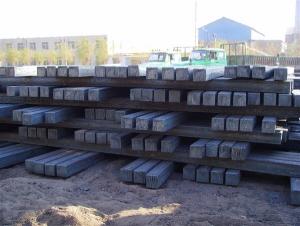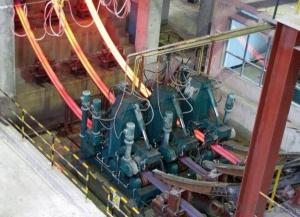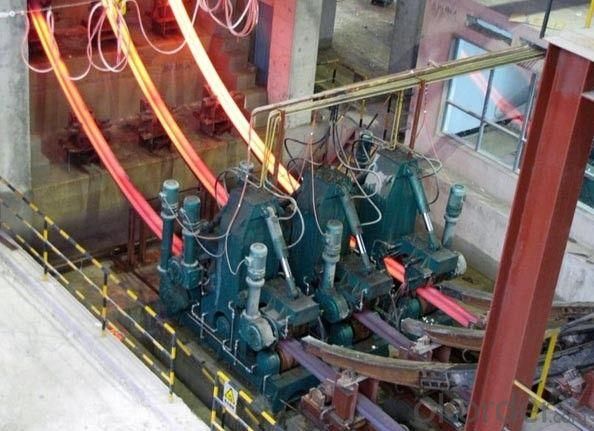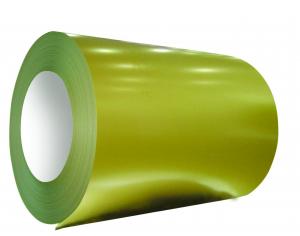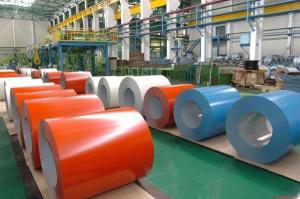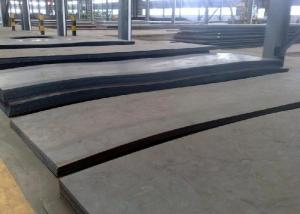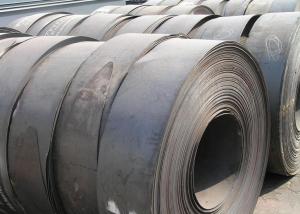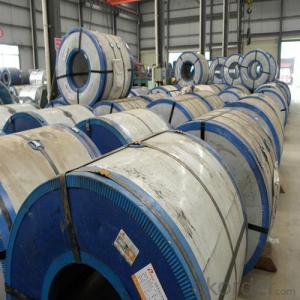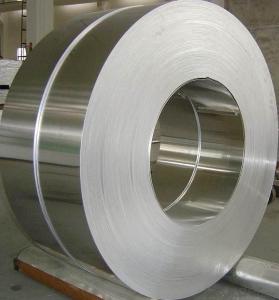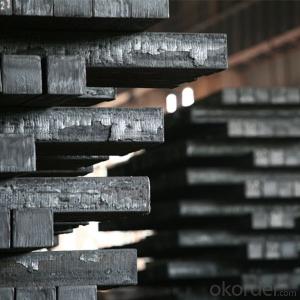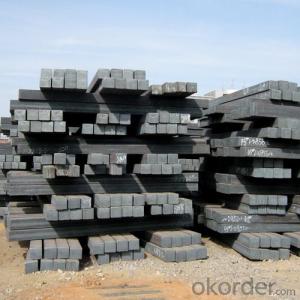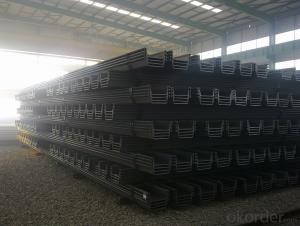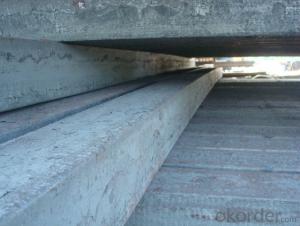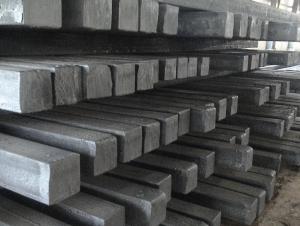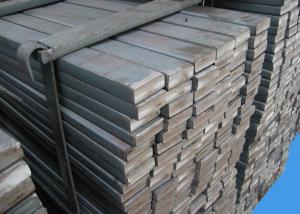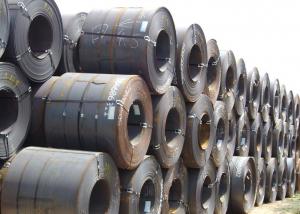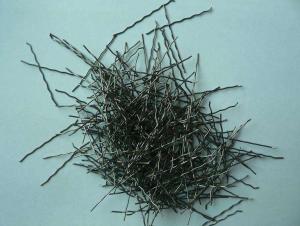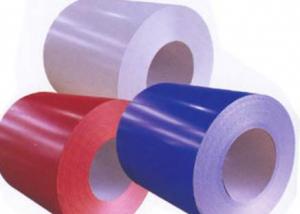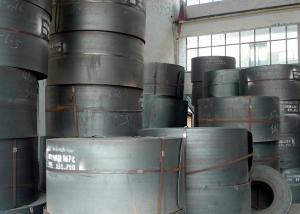Steel Billet
- Loading Port:
- China Main Port
- Payment Terms:
- TT OR LC
- Min Order Qty:
- -
- Supply Capability:
- -
OKorder Service Pledge
OKorder Financial Service
You Might Also Like
Packaging & Delivery
| Packaging Detail: | in bundles |
| Delivery Detail: | according to the quantity |
Specifications
square steel billet
1.3SP, 5SP
2.terms of payment: L/C at sight
3.size: 120*120mm
4.length: 5.8~12m
square steel billet
Specifications
square steel billets
1)We procure world class quality steel billets which meets the specific requirements of the clients
The Billets produced by the company can be broadly divided into three main types i.e.
M.S. Billets
CRS Billets
Special Alloy Billets
M.S. Billets are used for rolling of TMT Re-Bars of Fe415 and Fe500 Grade and various other structural steel products.
CRS Billets are used fro rolling of CRS TMT Re-Bars.
Special Alloy Billets are used for rolling of any special grade TMT Re-Bars like Earthquake resistant TMT Re-Bars and for special grade structural steel products.
The following are the sizes of Billets available with Shyam Steel Industries Ltd.:
100 X 100
120x120
150 X 150
Physical Properties:
Description | As per IS 2830 | Shyam Billets |
| Bend (max.) | 5 mm per meter | >= 5 mm per meter |
| Carbon (max.) | 3mm per meter | >= 3 mm per meter |
| Length | 3 mt - 13 mt | 3 mt - 9 mt |
Chemical Properties:
Ladle Analysis: | ||
Designation | Carbon | Manganese |
| C15 | 0.12-0.18 | 0.30-0.60 |
| C18 | 0.15-0.21 | 0.30-0.60 |
| C20 | 0.17-0.23 | 0.30-0.60 |
| C15 MMn | 0.12-0.18 | 0.60-1.00 |
| C18 MMn | 0.15-0.21 | 0.60-1.00 |
| C20 MMn | 0.17-0.23 | 0.60-1.00 |
| C15 HMn | 0.12-0.18 | 1.00-1.50 |
| C18 HMn | 0.15-0.21 | 1.00-1.50 |
C20 HMn | 0.17-0.23 | 1.00-1.50 |
Billets of different designations are manufactured in three different grades namely A, B, C having sulphur, phosphorous content (on ladle analysis) and carbon equivalent as follows:
| Chemical Analysis: | |||
| Grade | Sulphur | Phosphorous | Carbon Equivalent (CE)1 |
| Max | Max | Max | |
| A | 0.05 | 0.05 | 0.42 |
| B | 0.045 | 0.045 | 0.41 |
| C | 0.04 | 0.04 | 0.39 |
- Q: What are the different types of steel springs and their uses?
- There are several types of steel springs, each designed for specific applications. Some common types include compression springs, which are used to resist compressive forces and store energy; extension springs, which resist stretching and are commonly found in trampolines or garage doors; torsion springs, which generate rotational force and are used in clothespins or mousetraps; and flat springs, which provide flexibility in limited spaces, such as in automotive suspensions. Each type of spring has a unique design and purpose, allowing them to be utilized in a wide range of industries and products.
- Q: How is steel used in the manufacturing of material handling equipment?
- Steel is commonly used in the manufacturing of material handling equipment due to its strength, durability, and versatility. It is used to create the frames, supports, and components of various equipment such as forklifts, cranes, conveyors, and storage racks. Steel's high tensile strength allows these equipment to handle heavy loads and withstand the rigors of daily use in industrial environments. Additionally, steel can be easily shaped, welded, and machined, making it an ideal choice for creating complex and customized designs required in material handling equipment.
- Q: How are steel pipes used in oil and gas pipelines?
- Steel pipes are commonly used in oil and gas pipelines due to their strength, durability, and resistance to harsh environments. These pipes are used to transport oil and gas from extraction sites to refineries and end-users. They are laid underground or underwater and can handle high pressure and temperature variations. The steel pipes also provide protection against corrosion and external damage, ensuring a safe and efficient flow of oil and gas throughout the pipeline network.
- Q: How is steel used in the production of automotive components?
- Steel is used in the production of automotive components due to its strength, durability, and affordability. It is commonly used to make parts such as the body frame, engine components, suspension systems, and exhaust systems. The high strength of steel ensures the safety and structural integrity of the vehicle, while its durability allows the components to withstand harsh conditions and prolonged usage. Additionally, steel's cost-effectiveness makes it a preferred choice for manufacturers, enabling them to produce reliable and affordable automotive components.
- Q: What are the different types of heat treatment processes for steel?
- There are several different types of heat treatment processes for steel, including annealing, normalizing, quenching, tempering, case hardening, and precipitation hardening. Each process has its own specific purpose and effects on the steel's properties.
- Q: How do steel products contribute to the agriculture and farming sector?
- Steel products contribute to the agriculture and farming sector in several ways. Firstly, steel is used in the manufacturing of machinery and equipment essential for agricultural activities, such as tractors, combines, plows, and irrigation systems. These machines help increase efficiency, reduce labor, and improve productivity on farms. Additionally, steel structures, such as barns, silos, and storage facilities, provide durable and secure spaces for storing crops, livestock, and equipment. Steel is known for its strength, durability, and resistance to weather conditions, making it ideal for protecting agricultural resources. Furthermore, steel is used in the construction of infrastructure such as bridges and roads, which play a crucial role in connecting farms to markets and facilitating the transportation of goods. This infrastructure ensures that agricultural products can reach consumers in a timely and efficient manner. Overall, steel products contribute significantly to the agriculture and farming sector by enhancing productivity, providing storage solutions, and supporting the necessary infrastructure for the smooth functioning of the industry.
- Q: How is steel used in the production of playground equipment?
- Steel is commonly used in the production of playground equipment due to its strength, durability, and ability to withstand outdoor elements. It is used to construct the frames, supports, and chains of various play structures such as swings, slides, and climbing frames. Steel's robust nature ensures the equipment can safely support the weight of children and withstand frequent use and harsh weather conditions, making it an ideal material for playground equipment.
- Q: What are the different types of steel shelving and storage systems available?
- There are several different types of steel shelving and storage systems available, including boltless shelving, wire shelving, pallet racking, cantilever racking, and mezzanine systems. Boltless shelving is easy to assemble and adjust, making it versatile and suitable for various storage needs. Wire shelving is durable and allows for better airflow and visibility, making it popular for use in retail and food storage. Pallet racking is designed to store palletized goods and is commonly used in warehouses and distribution centers. Cantilever racking is ideal for storing long and bulky items such as pipes or lumber. Mezzanine systems create additional floor space by utilizing the vertical height of a facility. These different types of steel shelving and storage systems offer various benefits and can be tailored to suit specific storage requirements.
- Q: What are the different types of steel pipes and their uses?
- There are several types of steel pipes, including carbon steel pipes, stainless steel pipes, alloy steel pipes, and galvanized steel pipes. Carbon steel pipes are commonly used for transporting fluids and gases, while stainless steel pipes are preferred in industries requiring corrosion resistance. Alloy steel pipes are suitable for high-temperature and high-pressure applications, and galvanized steel pipes are used for water supply and plumbing systems due to their rust resistance.
- Q: How is steel used in the production of renewable energy systems?
- Steel is commonly used in the production of renewable energy systems due to its durability, strength, and cost-effectiveness. It is used in the construction of wind turbines, solar panels, and hydroelectric power plants, providing structural support and ensuring their long-term reliability. Additionally, steel is used in the manufacturing of transmission towers and infrastructure for renewable energy systems, allowing for efficient distribution of clean energy to communities.
Send your message to us
Steel Billet
- Loading Port:
- China Main Port
- Payment Terms:
- TT OR LC
- Min Order Qty:
- -
- Supply Capability:
- -
OKorder Service Pledge
OKorder Financial Service
Similar products
Hot products
Hot Searches
Related keywords
